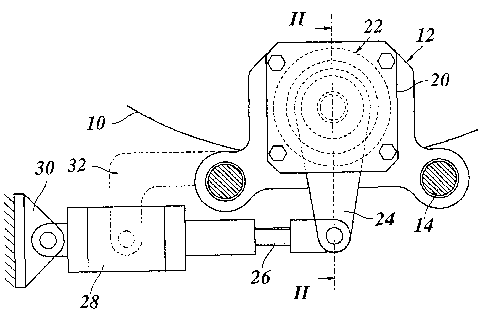Some of the information on this Web page has been provided by external sources. The Government of Canada is not responsible for the accuracy, reliability or currency of the information supplied by external sources. Users wishing to rely upon this information should consult directly with the source of the information. Content provided by external sources is not subject to official languages, privacy and accessibility requirements.
Any discrepancies in the text and image of the Claims and Abstract are due to differing posting times. Text of the Claims and Abstract are posted:
| (12) Patent Application: | (11) CA 2473972 |
|---|---|
| (54) English Title: | BRAKE, ESPECIALLY FOR WIND FARMS |
| (54) French Title: | FREIN, EN PARTICULIER POUR AEROGENERATEUR |
| Status: | Deemed Abandoned and Beyond the Period of Reinstatement - Pending Response to Notice of Disregarded Communication |
| (51) International Patent Classification (IPC): |
|
|---|---|
| (72) Inventors : |
|
| (73) Owners : |
|
| (71) Applicants : |
|
| (74) Agent: | KIRBY EADES GALE BAKER |
| (74) Associate agent: | |
| (45) Issued: | |
| (86) PCT Filing Date: | 2002-07-23 |
| (87) Open to Public Inspection: | 2003-09-18 |
| Examination requested: | 2007-07-05 |
| Availability of licence: | N/A |
| Dedicated to the Public: | N/A |
| (25) Language of filing: | English |
| Patent Cooperation Treaty (PCT): | Yes |
|---|---|
| (86) PCT Filing Number: | PCT/EP2002/008175 |
| (87) International Publication Number: | EP2002008175 |
| (85) National Entry: | 2004-07-21 |
| (30) Application Priority Data: | ||||||
|---|---|---|---|---|---|---|
|
Brake, in particular for wind power plants, comprising a set of brake shoes
(16, 18)
and an actuator (28) for the brake shoes, characterised in that the actuator
(28) acts
upon a lever (24) which is pivotable in a plane in parallel with the brake
shoes (16,
18) and acts upon the brake shoes (16, 18) through a transmission (22) which
trans-
lates the pivotal movement into an axial movement.
L'invention concerne un frein, en particulier pour aérogénérateur, comprenant un ensemble de mâchoires de frein (16, 18) et des moyens d'entraînement (28) desdites mâchoires de frein, caractérisé en ce que les moyens d'entraînement (28) sont en prise avec un levier (24) qui est monté pivotant dans un plan parallèle aux mâchoires (16, 18) et qui agit sur les mâchoires (16, 18), via une transmission (22) qui transforme le mouvement de pivotement en un déplacement axial.
Note: Claims are shown in the official language in which they were submitted.
Note: Descriptions are shown in the official language in which they were submitted.

2024-08-01:As part of the Next Generation Patents (NGP) transition, the Canadian Patents Database (CPD) now contains a more detailed Event History, which replicates the Event Log of our new back-office solution.
Please note that "Inactive:" events refers to events no longer in use in our new back-office solution.
For a clearer understanding of the status of the application/patent presented on this page, the site Disclaimer , as well as the definitions for Patent , Event History , Maintenance Fee and Payment History should be consulted.
| Description | Date |
|---|---|
| Inactive: IPC expired | 2016-01-01 |
| Application Not Reinstated by Deadline | 2010-07-23 |
| Time Limit for Reversal Expired | 2010-07-23 |
| Deemed Abandoned - Failure to Respond to Maintenance Fee Notice | 2009-07-23 |
| Letter Sent | 2009-03-13 |
| Inactive: Single transfer | 2009-01-14 |
| Letter Sent | 2007-08-24 |
| All Requirements for Examination Determined Compliant | 2007-07-05 |
| Request for Examination Requirements Determined Compliant | 2007-07-05 |
| Request for Examination Received | 2007-07-05 |
| Inactive: IPC from MCD | 2006-03-12 |
| Inactive: IPC from MCD | 2006-03-12 |
| Letter Sent | 2004-11-17 |
| Inactive: Single transfer | 2004-10-22 |
| Inactive: Cover page published | 2004-09-28 |
| Inactive: Delete abandonment | 2004-09-28 |
| Inactive: Courtesy letter - Evidence | 2004-09-28 |
| Inactive: Office letter | 2004-09-28 |
| Inactive: First IPC assigned | 2004-09-26 |
| Inactive: Notice - National entry - No RFE | 2004-09-24 |
| Application Received - PCT | 2004-08-23 |
| Deemed Abandoned - Failure to Respond to Maintenance Fee Notice | 2004-07-23 |
| National Entry Requirements Determined Compliant | 2004-07-21 |
| Application Published (Open to Public Inspection) | 2003-09-18 |
| Abandonment Date | Reason | Reinstatement Date |
|---|---|---|
| 2009-07-23 | ||
| 2004-07-23 |
The last payment was received on 2008-06-10
Note : If the full payment has not been received on or before the date indicated, a further fee may be required which may be one of the following
Patent fees are adjusted on the 1st of January every year. The amounts above are the current amounts if received by December 31 of the current year.
Please refer to the CIPO
Patent Fees
web page to see all current fee amounts.
| Fee Type | Anniversary Year | Due Date | Paid Date |
|---|---|---|---|
| MF (application, 2nd anniv.) - standard | 02 | 2004-07-23 | 2004-07-21 |
| Basic national fee - standard | 2004-07-21 | ||
| Registration of a document | 2004-07-21 | ||
| MF (application, 3rd anniv.) - standard | 03 | 2005-07-25 | 2005-07-12 |
| MF (application, 4th anniv.) - standard | 04 | 2006-07-24 | 2006-07-18 |
| MF (application, 5th anniv.) - standard | 05 | 2007-07-23 | 2007-06-13 |
| Request for examination - standard | 2007-07-05 | ||
| MF (application, 6th anniv.) - standard | 06 | 2008-07-23 | 2008-06-10 |
| Registration of a document | 2009-01-14 |
Note: Records showing the ownership history in alphabetical order.
| Current Owners on Record |
|---|
| GABOR-JOSEF AGARDY |
| JUERN EDZARDS |
| Past Owners on Record |
|---|
| JURN EDZARDS |